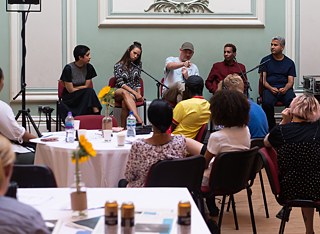Arrival City
Interview with Niloo Sharifi

Niloo Sharifi is the curator for Arrival City in the UK, a project focusing on migration and how it shapes cities. Here, she tells us about immigration in Toxteth, Liverpool, which historically is home to England’s oldest black population; the role of art in civil society; and why architecture is vital for community building.
Arrival City looks at how migration shapes cities and how cities are built to respond to, even encourage immigration. What got you interested in the project in the first place?
I myself am an immigrant. I was born in Liverpool, then moved to Iran, and then moved back to Liverpool. So I have experienced arrival and leaving through a few different angles. Liverpool is interesting as an arrival city historically and currently. It is a modern arrival city, especially in Toxteth (postcode L8), an area of Liverpool that by far has the highest numbers of migrants in the city.
I was actually born in Toxteth and it was interesting to me as an area that was a starting point for a lot of migrants, such as my parents. The area fulfills many of the conditions that the Arrival City framework notes and that make it attractive as a starting point for immigrants - for instance there is already an existing network for new arrivals, the area is close to business, rent is cheap and so on.
But what fascinated me even more was that these conditions were predicated on a previous set of conditions for immigrants, since Liverpool has such a long history of immigration. Being home to England’s oldest black population and Europe’s oldest Chinese population. So you can compare the history of how immigrants were received and treated in the past to conditions now.
Your focus is on Toxteth, an area of Liverpool with historically high levels of immigration and racial tensions. Tell us more about your plans there with FACT and for Toxteth Reservoir in particular.
FACT [FACT Liverpool], who I am working with, already have a number of projects in L8. Our collaboration focusses on the Toxteth Reservoir, which is this structure that has been disused for many years that used to hold water. FACT already have a project called Aurora which uses the reservoir as an arts space with Invisible Flock [an interactive art collective LINK]. Aurora is environmentally focused and all about water and the effect water has on our lives.
The reason we found a natural affinity between our projects, on top of just the location, was that in Liverpool the story of migration is closely intertwined with the story of water, because of the city’s position as a port. The project we are piloting in July, ahead of a larger event in the reservoir in September [LINK], is based on Liverpool’s history as a city of performance and the spoken word, which also emerged in part from migration and the mixed influences that come from that.
We will have a series of performers, musicians, spoken word artists and actors who will perform on topics surrounding the issue of migration. On top of that, there will be a market place. The idea is to view a market as a place of ideas, as well as a physical market place. Both describe the cultural exchange that needs to happen for the integration of immigrants. I was interested in the parallel of commercial integration and cultural integration – both vital for the longevity of a migrant community’s success.
Because of the history of L8 being so complicated and made up of so many different perspectives, it felt wrong for someone from the outside, even though I have a personal connection to the area, to come in and impose my particular story. The worst thing I could do is to say: This is what L8 is as an arrival city. I thought that I would be more likely to get a richer result if I asked the actual people who live there. They will have so many more perspectives that my own experience and research can open up to me. The community here is very engaged.
What role does art play in civil society?
I really like art works at the intersection of a representational object and something that is of practical use in real life. When I went to Frankfurt with the Goethe-Institut for the first Arrival City conference, I heard a talk by an expert on curation who said something that really resonated with me. His talk was called ‘Curation and Caring’ and it was about how the job of the curator when working on identity and marginalised groups is not to show the conditions of someone’s life in a representational way (i.e. hang photos of shops run by migrants), but rather to create a moment that has the ability to connect the immigrant community to the wider community. So that’s what I’m trying to do by involving artists, civil society actors, and members of the public. I think you lose richness when you try to get to an objective truth on something that in reality is so subjective.
the places where we meet, shape the way that we see ourselves as a group of people
You also have a keen interest in architecture and have said that you admire Danish architect Bjarke Ingels’ 8 House for instance. Why, in your view, is architecture vital for community building?
I think that the places where we meet, shape the way that we see ourselves as a group of people. If the place where you live is somewhere were it’s easy to connect, where you feel like the architecture almost wants you to talk to other people and encourages you to meet other people that has an impact not only on individual self-esteem but the self-esteem of a community. It can influence how a community sees itself and its prospects.
So much of social progress is about aspiration and I think that bad architecture has the opposite effect. When it seems that the place where you live doesn’t care if you have a nice view or if you feel constricted or if you live next door to a place that has completely broken down and has been left like that for months. If that’s what your environment looks like, it creates a sense of what your life and your prospects can also look like. I notice that a lot when I go to London. There’s something about the architecture that puts a spring in people’s steps. I am not saying that is always what we should aspire to everywhere, but something about the tallness of the buildings creates a sense of self-importance. When I went to Berlin for the first time, I found the architecture really relaxing. We have these very visceral reactions to places where we live. The 8 House for example is someone taking their expertise and technical knowledge and centering that on creating visceral sensations through the design.
I think also in L8 there is a link between the way the streets look and the way that people feel about their lives and their goals. I just moved back to Toxteth and there’s a house down my street that has piles and piles of rubbish outside of it and it’s just been left like that for weeks. It’s fine, kids still play in the street, but it creates a sense that somehow you are living in the back corner or back alley of society.
the worst thing that could happen to Toxteth is gentrification
What are your hopes for the future of L8?
It’s frustrating because I think so many people are doing great things in the area, but often social enterprises come in to change an area and then leave quickly again. FACT’s projects however have a policy of not just turning up for 6 weeks and then going away. They try to keep people engaged and make projects sustainable. I think a lot of people do great sustained work. But they can only do so much on their own. So my hope would be that the attention drawn to Toxteth now is redoubled by the council and a certain amount of government funding that is then combined with local expertise and efforts.
For example down my road there is a little plot that has been taken over by a trust, which will create flats and then give them back to the community. That’s a great initiative. I think the best thing is when people get investment from outside, but involving the leadership of the community. I think that the worst thing that could happen to Toxteth is gentrification. This is what happened to the Georgian quarter, which used to be the city’s red light district. At a certain point its image was reupholstered. The policing and pricing moved its residents out of the area and further away from the city centre. When I think about Toxteth improving that’s kind of the opposite of what I mean. Because the residents being outpriced will mean they move somewhere else and the problem is just shifted. So you need to find different systems of improving areas while keeping the power with the people who are already there.
Arrival City presents a portrait of Liverpool, and more specifically Toxteth, as a city of immigration. The project aims to open up conversations about immigration in Liverpool, and offer a chance to address and improve upon the toxicity of popular discourse around migration.
